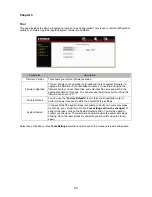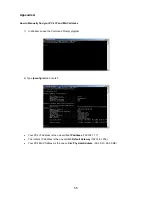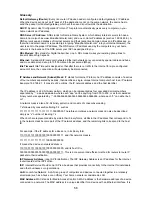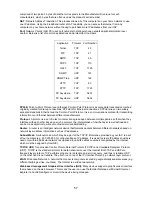
comprised of two parts: 3 bytes of data that corresponds to the Manufacturer ID (unique for each
manufacturer), plus 3 bytes that are often used as the product’s serial number.
NAT:
Network Address Translation. This process allows all of the computers on your home network to use
one IP address. Using the broadband router’s NAT capability, you can access the Internet from any
computer on your home network without having to purchase more IP addresses from your ISP.
Port:
Network Clients (LAN PC) uses port numbers to distinguish one network application/protocol over
another. Below is a list of common applications and protocol/port numbers:
Application Protocol
Port
Number
Telnet TCP 23
FTP TCP 21
SMTP TCP 25
POP3 TCP 110
H.323 TCP 1720
SNMP UCP 161
SNMP Trap
UDP
162
HTTP TCP 80
PPTP TCP 1723
PC Anywhere
TCP
5631
PC Anywhere
UDP
5632
PPPoE:
Point-to-Point Protocol over Ethernet. Point-to-Point Protocol is a secure data transmission method
originally created for dial-up connections; PPPoE is for Ethernet connections.
PPPoE
relies on two widely
accepted standards, Ethernet and the Point-to-Point Protocol. It is a communications protocol for transmitting
information over Ethernet between different manufacturers
Protocol:
A protocol is a set of rules for interaction agreed upon between multiple parties so that when they
interface with each other based on such a protocol, the interpretation of their behavior is well defined and
can be made objectively, without confusion or misunderstanding.
Router:
A router is an intelligent network device that forwards packets between different networks based on
network layer address information such as IP addresses.
Subnet Mask:
A subnet mask, which may be a part of the TCP/IP information provided by your ISP, is a set
of four numbers (e.g. 255.255.255.0) configured like an IP address. It is used to create IP address numbers
used only within a particular network (as opposed to valid IP address numbers recognized by the Internet,
which must be assigned by InterNIC).
TCP/IP, UDP:
Transmission Control Protocol/Internet Protocol (TCP/IP) and Unreliable Datagram Protocol
(UDP). TCP/IP is the standard protocol for data transmission over the Internet. Both TCP and UDP are
transport layer protocol. TCP performs proper error detection and error recovery, and thus is reliable. UDP
on the other hand is not reliable. They both run on top of the IP (Internet Protocol), a network layer protocol.
WAN:
Wide Area Network. A network that connects computers located in geographically separate areas (e.g.
different buildings, cities, countries). The Internet is a wide area network.
Web-based management Graphical User Interface (GUI):
Many devices support a graphical user interface
that is based on the web browser. This means the user can use the familiar Netscape or Microsoft Internet
Explorer to Control/configure or monitor the device being managed.
57

































